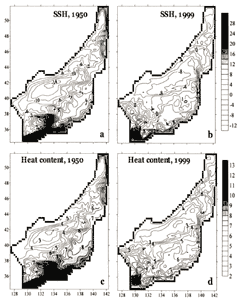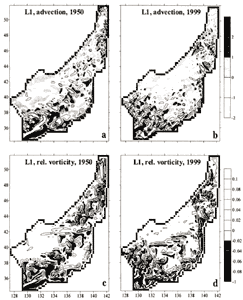|
RESULTS OF NUMERICAL EXPERIMENTS
Simulated circulation and heat content and advection in the Japan Sea
The general circulation in the Japan Sea is realistically simulated in both
experiments; current velocity is shown in Figures 4 and 5 in ( Trusenkova
et al., 2003). It is consistent with circulation schemes derived from observations such as ( Sizova, 1961) and simulations by other models, such as ( Yoon and Kawamura, 2002). The cyclonic gyre simulated in the northwest Japan Sea and Tatarsky Strait is characterized by sea surface depression (Figs. 2, 5) and by doming structure in topography of interfacial surfaces between layers (Figs.6, 7; Trusenkova et al., 2003). The cyclonic gyre is intensified in the 1950 Experiment, compared to 1999: sea surface height (SSH) difference between its center and the subtropical area is of about 24-28 cm in the former case and 16-20 cm in the latter case (Fig.2; Trusenkova et al., 2003).
| (Enlarge: 64KB) |
 |
Figure 2. Sea surface height (cm; a, b) and heat content of the upper (250
m) baroclinic layer (109 J/m-2; c, d) in summer (August
1) for the 1950 (a, c) and 1999 (b, d) Experiments
Simulated branches of the Tsushima Warm Current carry subtropical water from
the Tsushima Strait northward to the northeast Japan Sea and Tatarsky Strait, where buoyant water is seen
as elevation of the sea surface (Fig.2). Anticyclonic circulation off La Perouse Strait is reproduced
in geostrophic currents by Sizova (1961). The eastern branches of the Tsushima
Current are intensified in the 1950 Experiment, while the western branch, the East Korea Warm Current
(EKWC) flowing northward along the Korean coast is intensified in the 1999 Experiment ( Trusenkova
et al., 2003). The sea surface elevation associated with the EKWC develops as far north as 40°N in
the western sea (westward of 131°E) in 1999 (Fig.2b), while sea surface depression associated with the
cyclonic gyre reaches as far south as 37°N in 1950 (Fig.2a). The simulated circulation pattern in the
northwest Japan Sea for 1999 is in agreement with observational evidence from satellite imagery and ship
measurements. Observed warm streamers and eddies originating from the EKWC penetrate as far north as 42°N
( westward of 132°E; Danchenkov et al., 1997).
With direct wind forcing, anticyclonic wind stress curl over this area caused by adjacent land orography
can strengthen the anticyclonic circulation.
| (Enlarge: 65KB) |
 |
Figure 3. Horizontal heat advection (103 wt/m2;
a,b) and relative vorticity (10-4 s-1; c,d) in the
upper layer (summer) for the 1950 (a,c) and 1999 (b,d) Experiments
The first and second (eastern) branches of the Tsushima Warm Current flow along
the Honshu coast over the shelf and slope ( Kawabe, 1982). In our experiments
they are simulated as a single stream or separate jets ( Trusenkova et al.,
2003). Besides, in both cases a meandering jet is simulated in the interior southeast region over
the Oki Bank (centered at 133°E, southward of 37°30'N in Fig.1b) and Yamato
Rise (centered at 134°E, southward of 40°30'N in Fig.1b). It is clearly seen
in current velocity (Figs. 4, 5; Trusenkova
et al., 2003) and also as a ridge of increased SSH (Figs.2a, 2b, 5a, 5d).
The presence of warm water and temperature fronts in this area is supported by observational evidence;
temperature patterns reveal considerable interannual and mesoscale variability ( Kawabe,
1982).
Westward branches of the Tsushima Current Extension flow across the sea off
the eastern to western coast in the northern Japan Sea and southern Tatarsky Strait. The westward jets
are simulated along 42°- 43°N, 44°N, 45°N, 46°N, and, in summer 1999, along 46°30'-47°N ( Trusenkova
et al., 2003). Cyclonically bended contours correspond to these jets in the SSH distribution (Figs.2a,
2b, 5a, 5d). The westward current across the Japan Sea off the Tsugaru Strait
is reproduced in geostrophic circulation by Sizova (1961) and has already
been simulated by numerical models ( Ponomarev et al., 2001b; Yoon
and Kawamura, 2002).
Distribution of heat content of the upper (250 m) baroclinic layer closely follows circulation patterns in both cases (Fig.2). Heat content is low inside the subarctic gyre in the northwest Japan Sea and northern Tatarsky Strait and high in the southeast region of warm currents (Fig.2). Heat content is lowest (of 2.3-109-2.35-109J/m2) in the center of the cyclonic gyre (around 133°- 133°30'E, 41°30'- 42°N with lowest SSH) in 1950, while in 1999 heat content inside the cyclonic gyre is above 2.4.109J/m2. In the southeast Japan Sea heat content is higher in 1950: it is more than 10.0-109J/m2 in the anticyclonic meander over the Oki Bank with extreme sea surface elevation over 20 cm (Fig.2). In contrast, the western Japan Sea (westward of 132°E) is warmer in 1999: heat content is over 5.0-109J/m2 as far north as 39°30'N, while it is under 4.5-109J/m2 as far south as 38°- 39°N in 1950 (Figs.2c, d). Contrast in heat content between the subarctic and subtropical regions is higher in 1950 due to intensification of the cyclonic gyre.
Heat advection is estimated from the horizontal advective terms of the transport
equation for temperature. Positive advection is highest within mesoscale circulation features associated
with warm currents, such as anticyclonic meanders and eddies. In both experiments patterns of heat advection
closely match patterns of relative vorticity. The latter also has extreme values within mesoscale features
(Fig.3). In the 1950 Experiment, heat is mostly advected from the Tsushima Strait northward in the eastern
Japan Sea (Fig.3a). In contrast, in the 1999 Experiment, northward heat advection is higher in the western
Japan Sea (Fig.3b). Chains of anticyclonic eddies seen as curved belts of high positive advective heat
flux and of anticyclonic vorticity form eddy streets considered as an important device of heat transport.
Eddy streets were documented in infrared satellite images of the northwest and central Japan Sea ( Danchenkov
et al., 1997). As, with the present spatial and temporal resolution ( Table
1), simulated eddies do not move, heat is advected by mesoscale currents associated with them. In
both experiments, heat is advected to the northwest Japan Sea from the east with the westward branches
of the Tsushima Current Extension. Curved patches of positive advection coincide with the current jets
across the sea in the 42°- 44°N band in summer 1950 and in the 45°- 47°N band in summer 1999 (Fig.3). |